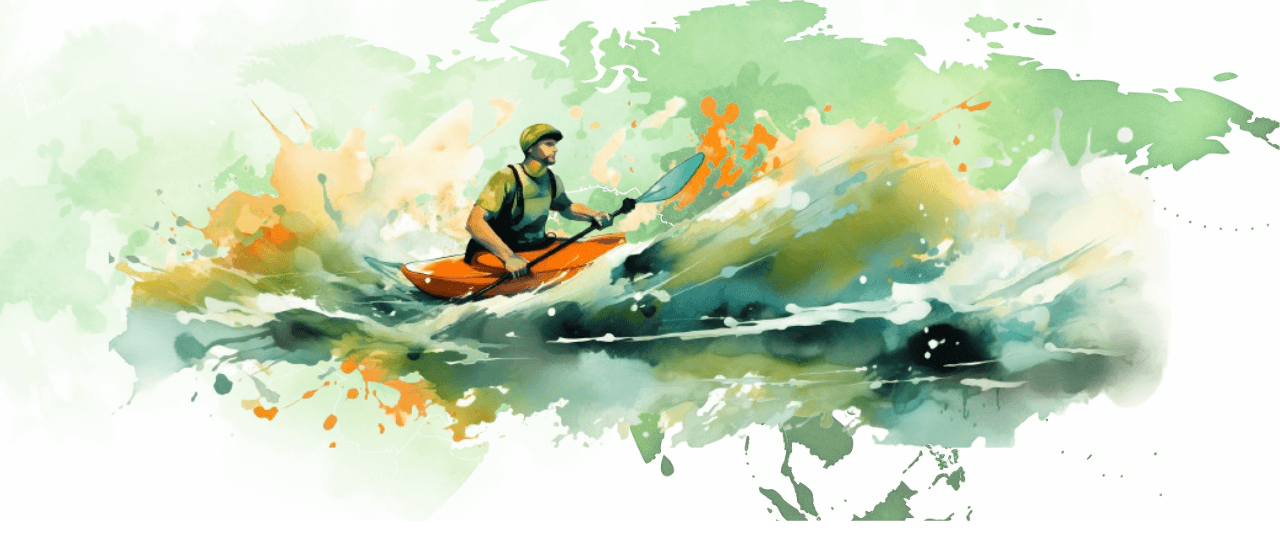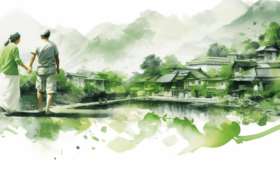Asia, a continent celebrated for its vast and varied landscapes, is also a treasure trove of exhilarating water adventures. From the coral-rich waters of the Indonesian archipelago to the mighty rivers of India, Asia offers a diverse array of aquatic experiences that cater to thrill-seekers and nature lovers alike. Each destination in this vast continent presents thrilling water adventures, whether it’s snorkeling in the crystal-clear waters of Thailand’s Similan Islands, challenging the rapids of the Ganges River, or kayaking through the serene lagoons of the Philippines.
What makes these water adventures even more appealing is their accessibility to beginners and seasoned enthusiasts. Activities like scuba diving in the Coral Triangle and surfing in Bali provide comprehensive training and guided experiences, ensuring that even novices can safely enjoy the thrills.
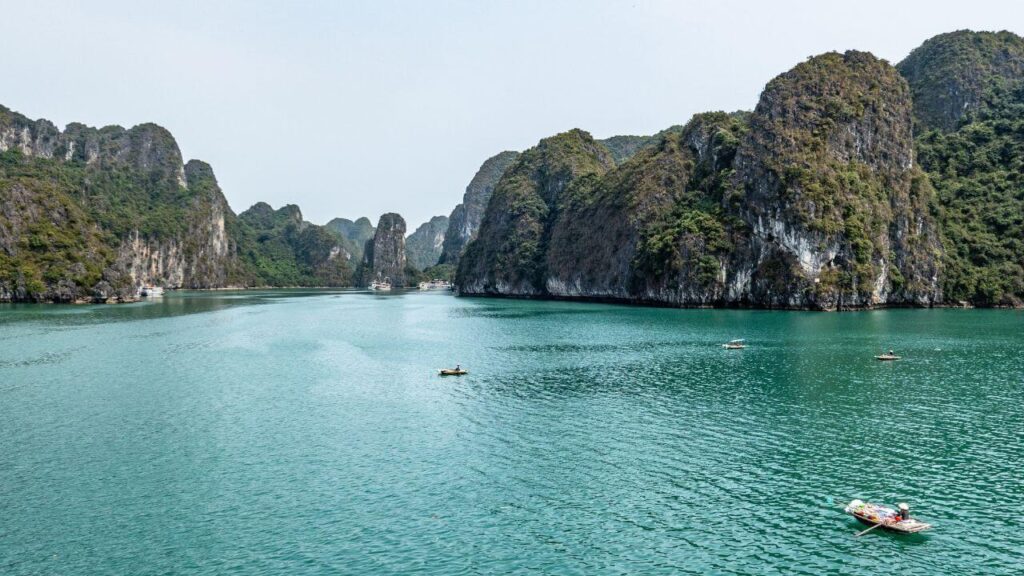
Embarking on these water adventures in Asia thus becomes a journey of personal exhilaration and a deeper appreciation and respect for nature’s marvels. This guide aims to navigate you through the top thrilling water adventures across Asia, highlighting the unique features of each experience while emphasizing the importance of safety and environmental stewardship.
Scuba Diving in the Coral Triangle (Indonesia, Philippines, Malaysia)
The Coral Triangle, an underwater marvel stretching across Indonesia, the Philippines, and Malaysia, is a mecca for scuba diving enthusiasts. Known as the global center of marine biodiversity, this region boasts an unrivaled variety of marine life. Home to over 75% of the world’s coral species and an astounding array of fish, turtles, sharks, and rays, the Coral Triangle offers a kaleidoscope of underwater experiences.
Rich Marine Biodiversity
Diving in the Coral Triangle is like entering a different world. The vibrant coral reefs serve as the backdrop for a diverse ecosystem. From the smallest nudibranchs and pygmy seahorses to the majestic manta rays and whale sharks, the range of marine life is simply breathtaking. Each dive spot within the Triangle has its own unique inhabitants and characteristics, making every dive a unique adventure.
Famous Dive Spots
Raja Ampat (Indonesia): Known for its pristine coral reefs and abundant marine life, it’s a top spot for experiencing diverse underwater habitats.
Tubbataha Reefs Natural Park (Philippines): A UNESCO World Heritage Site famous for its pelagic encounters, including sharks and large schools of fish.
Sipadan Island (Malaysia): is Renowned for its wall diving and frequent sightings of turtles and barracudas.

Best Time to Dive
The best time to dive in the Coral Triangle varies by location. Still, generally, the dry season, typically from March to October, offers the best conditions – calm seas and clear visibility. However, some areas might have specific peak months, so checking the local diving calendar is advisable.
Suitability
While scuba diving in the Coral Triangle can be family-friendly, it is generally more suited for older children and adults due to the need for certification and the physical demands of diving. Children over ten can enroll in Junior Diver programs, but it’s important to consider each child’s comfort and ability in the water. For families, many dive resorts offer snorkeling and other water-based activities suitable for all ages, allowing everyone to enjoy the region’s rich marine life.
White Water Rafting on the Ganges River (India)
White water rafting on the Ganges River in India offers an exhilarating blend of spiritual serenity and adventurous thrill. The Ganges, revered in Indian culture, winds through scenic landscapes, offering rapids ranging from mild to wildly challenging. Rafting on this iconic river provides an adrenaline rush and a unique opportunity to connect with the natural and cultural significance of the Ganges.
Navigating the Rapids
The Ganges River boasts a variety of rapids that cater to all levels of rafters, from beginners to experienced thrill-seekers. These rapids are classified based on their difficulty, from Grade I (easy, small waves) to Grade V (extremely challenging, large waves and rocks). Rafters can experience the thrill of battling through swirling waters while also enjoying moments of calm, drifting through serene stretches of the river, offering views of lush landscapes and ancient temples.
Rafting Routes and Difficulty Levels
Brahmpuri to Rishikesh: Ideal for beginners and families, featuring mostly Grade I and II rapids.
Shivpuri to Rishikesh: Offers a mix of Grade II and III rapids, suitable for those with a bit more experience.
Marine Drive to Rishikesh: This route includes more challenging Grade III and IV rapids, recommended for seasoned rafters.
Kaudiyala to Rishikesh: The most challenging route with Grade IV and V rapids, meant for expert rafters seeking a truly thrilling experience.
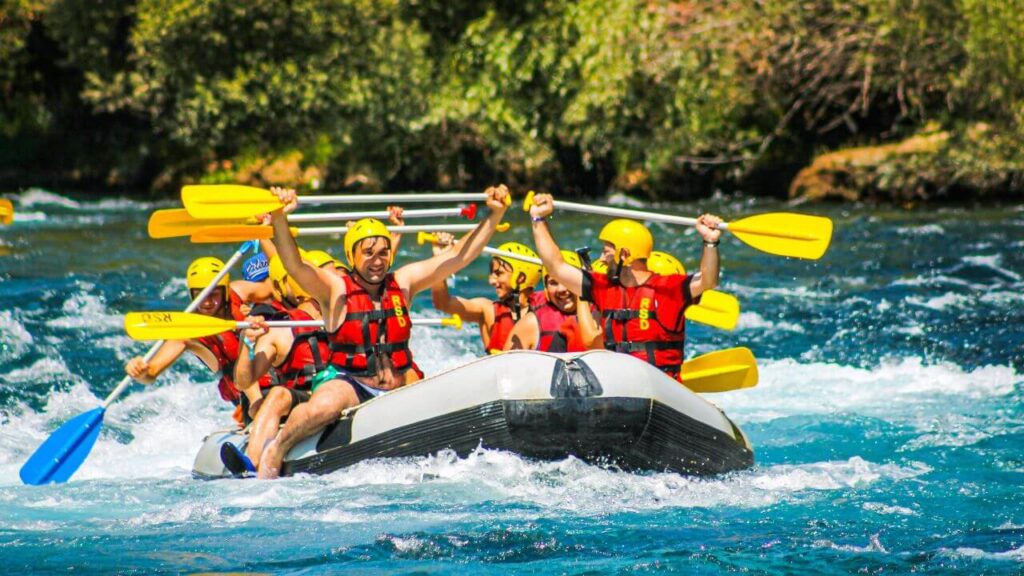
Best Time for Rafting
The ideal time for white water rafting on the Ganges is from late September to June. The post-monsoon season (September to November) offers the most exciting rafting conditions, with higher water levels making the rapids more challenging. The water levels and the rapids become more manageable as the season progresses, making it more suitable for beginners and families in the later months.
Suitability for Families, Children, and Seniors
White water rafting on the Ganges can be family-friendly, especially on milder routes like Brahmpuri to Rishikesh. These routes are suitable for children (usually above the age of 12) and can be enjoyed by adults and seniors who are in good health and comfortable in water. However, it’s important to choose a route that matches the skill level and physical capabilities of all participants. For seniors and very young children, or for those seeking a less intense experience, the gentler stretches offer a safe yet enjoyable way to experience the thrill of rafting.
Surfing in Bali (Indonesia)
Surfing in Bali is a dream for many wave enthusiasts, thanks to the island’s world-renowned surf spots, tropical climate, and vibrant culture. Bali’s surf scene caters to all levels, from beginners trying to catch their first wave to seasoned surfers looking for a challenging break. The island’s diverse coastline offers a variety of waves, making it a premier destination for surfers from around the globe.
Bali’s Famous Surf Spots
Kuta Beach: Ideal for beginners, Kuta’s long, soft break is perfect for learning and honing basic surfing skills.
Uluwatu: Known for its legendary left-hand break, Uluwatu is a magnet for experienced surfers seeking a thrilling ride.
Canggu: Offers a mix of breaks suitable for intermediate to advanced surfers, with a trendy beach atmosphere.
Padang Padang: Famous for its challenging barrel waves, it is best suited for advanced surfers.
Bingin Beach: A fast left-hand break over a coral reef, suitable for intermediate and experienced surfers.
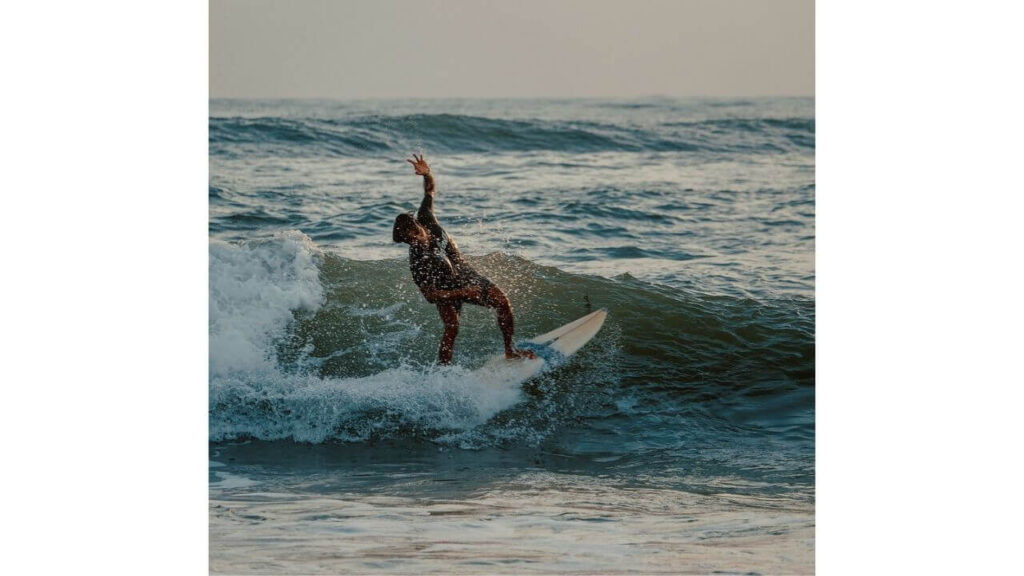
Best Time for Surfing in Bali
Bali’s surfing season can be broadly divided into two:
Dry Season (May to September): This is the peak surfing season in Bali, offering the best conditions with offshore winds and larger swells, particularly on the west coast.
Wet Season (October to April): The east coast of Bali becomes more favorable during this season, with smaller, more manageable waves ideal for beginners and intermediate surfers.
Tips for Beginners
- Choose the Right Spot: Start at beaches with smaller, more manageable waves like Kuta or Seminyak.
- Take Lessons: Numerous surf schools in Bali offer beginner courses which are a great way to learn proper techniques and safety.
- Respect the Locals: Bali has a strong surf culture. Understanding and respecting local customs and surf etiquette is crucial.
- Safety First: Always surf within your ability and be mindful of the ocean conditions and reef breaks.
Who Can Surf in Bali?
Surfing in Bali is an activity that caters to all ages, but it is most suitable for children, teenagers, and adults. While children as young as 6 or 7 can start learning to surf under professional supervision, it’s essential for them to be comfortable in the water. Adults of all ages can enjoy surfing, provided they are in good physical condition. Although surfing is physically demanding, many older adults enjoy the sport at a less intense level. Seniors can participate, especially on gentler waves, but should be mindful of their physical limitations and ocean safety. Surfing is a sport that truly epitomizes the spirit of “you’re only as old as you feel,” making it a fantastic activity for the young and the young at heart.
Kayaking in Ha Long Bay (Vietnam)
Kayaking in Ha Long Bay, Vietnam, is an enchanting experience, offering a unique way to explore the stunning beauty of this UNESCO World Heritage Site. Renowned for its emerald waters and thousands of towering limestone karsts and islets, Ha Long Bay presents an idyllic setting for kayaking enthusiasts. This activity allows for a closer and more personal encounter with the bay’s natural wonders, including hidden caves and secluded lagoons.
Exploring Limestone Karsts and Caves
Kayaking in Ha Long Bay provides an intimate experience of the bay’s majestic landscape. Paddling through the calm waters, visitors can navigate the various islets, glide under arches, and enter serene caves and caverns that larger boats cannot access. This exploration offers a peaceful escape and the chance to witness the bay’s wildlife and intricate geology up close.
Guided Tours and Independent Exploration
Guided Tours: Many operators in Ha Long Bay offer guided kayaking tours. These tours are ideal for those who prefer to explore with the knowledge and safety provided by experienced guides. They often include stops at popular attractions and hidden spots known only to locals.
Independent Kayaking: For the more adventurous, renting a kayak and exploring independently is an option. This allows for a more flexible and personal experience. However, it’s crucial to be aware of the bay’s weather and water conditions and to have basic navigation skills.
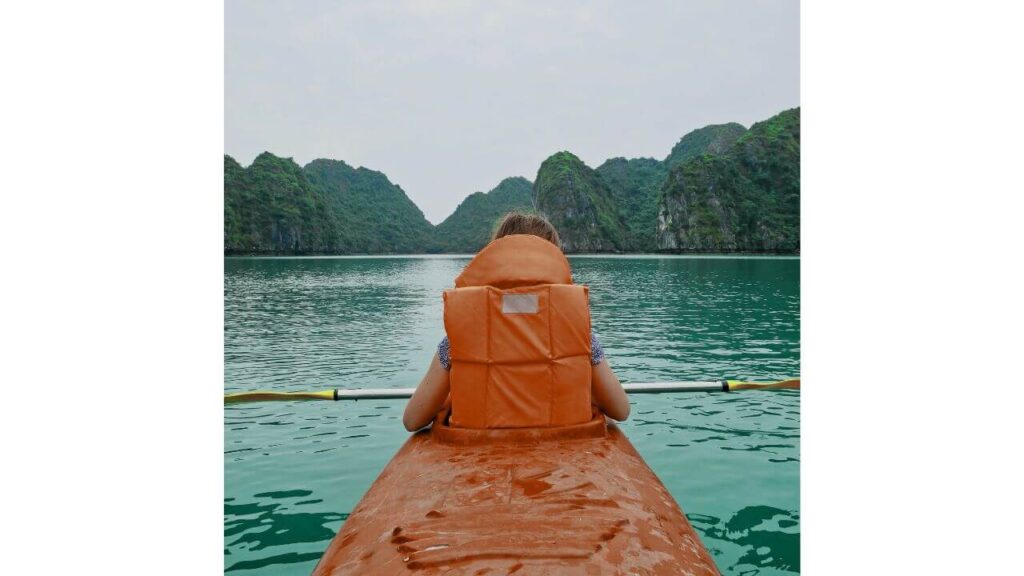
Best Time for Kayaking
The best time to kayak in Ha Long Bay is spring (March to May) and autumn (September to November). The weather is more temperate and stable during these periods, providing calm and clear conditions ideal for kayaking. Summers can be hot and humid with a higher chance of rain, while winters are cooler and might be less comfortable for water-based activities.
Family-Friendly Activity
Kayaking in Ha Long Bay is a family-friendly activity suitable for various ages and abilities. Children can participate, especially when accompanied by adults, and the activity can be a delightful experience for them. It’s an excellent way for families to bond while enjoying the bay’s natural beauty.
Seniors can also enjoy kayaking, provided they are in good physical condition and comfortable with the activity. Seniors and families with young children need to choose calmer routes and perhaps opt for guided tours, which can provide additional safety and support.
Jet Skiing in Phuket (Thailand)
Jet skiing in Phuket, Thailand, is a thrilling way to experience the beauty of the Andaman Sea, offering an adrenaline-pumping adventure against a backdrop of stunning seascapes. Known for its crystal-clear waters and picturesque coastlines, Phuket is a prime destination for water sports enthusiasts, and jet skiing here provides an exhilarating way to explore the island’s beautiful beaches and nearby islands.
The Adrenaline Rush in the Andaman Sea
Jet skiing in Phuket allows you to zip across the open waters, feeling the sea spray and the wind in your hair. It’s an opportunity to experience speed and freedom on the water, with the chance to witness the island’s natural beauty from a different perspective. Whether you’re skimming over the waves near popular beaches or exploring quieter areas along the coast, jet skiing offers a unique and exciting way to enjoy Phuket’s maritime environment.
Safety Measures and Rental Information
Safety First: Safety is paramount when it comes to jet skiing. Operators in Phuket typically provide life jackets and brief riders on safety protocols and handling techniques.
Choosing a Rental Service: There are numerous jet ski rental services available along Phuket’s beaches. It’s essential to choose a reputable operator that maintains their equipment well and offers clear instructions and safety briefings.
Rental Duration: Rentals can vary from a short 30-minute ride to several hours. Longer rentals often include the option to explore further afield, such as visiting nearby islands or quieter beaches.

Best Time for Jet Skiing in Phuket
The best time for jet skiing in Phuket is during the dry season, from November to April. During these months, the sea is usually calm, and the weather is sunny and clear, providing ideal conditions for water sports. The monsoon season, from May to October, can bring rougher seas and unpredictable weather, making it less suitable for jet skiing.
Suitability for Different Age Groups
Jet skiing is most suitable for adults and teenagers who can handle the physical demands of controlling a jet ski. Most rental services have an age limit for drivers, usually around 16-18 years, though this can vary.
For Kids: While younger children typically cannot drive jet skis, they can ride as passengers with an adult, depending on their comfort level with high-speed water activities.
For Seniors: Seniors can enjoy jet skiing if they are in good physical health, comfortable with high-speed activities, and have no major mobility issues. It’s important for seniors to assess their comfort and ability levels and to ride at a pace that feels safe for them.
Stand-Up Paddleboarding in Boracay (Philippines)
Stand-up paddleboarding (SUP) has rapidly gained popularity as a fun and accessible water sport, and Boracay in the Philippines is an ideal destination to experience it. Known for its stunning white-sand beaches and crystal-clear waters, Boracay offers a serene and picturesque setting for SUP enthusiasts of all skill levels.
The Popularity of Stand-Up Paddleboarding
SUP offers a unique blend of leisure and exercise, appealing to a wide audience. It’s less demanding than surfing, making it accessible to beginners, yet it can still provide a challenging workout for those who seek it. The calm waters of Boracay are perfect for paddleboarding, offering a peaceful way to explore the island’s natural beauty while standing on the water.
Ideal Spots in Boracay for SUP
White Beach: Known for its gentle waves and shallow waters, White Beach is perfect for beginners. The long stretch of beach offers plenty of space for paddleboarders to spread out and enjoy the serene surroundings.
Bulabog Beach: A bit more sheltered, this beach is great for those who have some experience with paddleboarding and are looking to practice their skills in a more controlled environment.
Diniwid Beach: Quieter and more secluded, Diniwid Beach is ideal for those who prefer a more tranquil paddleboarding experience away from the crowds.
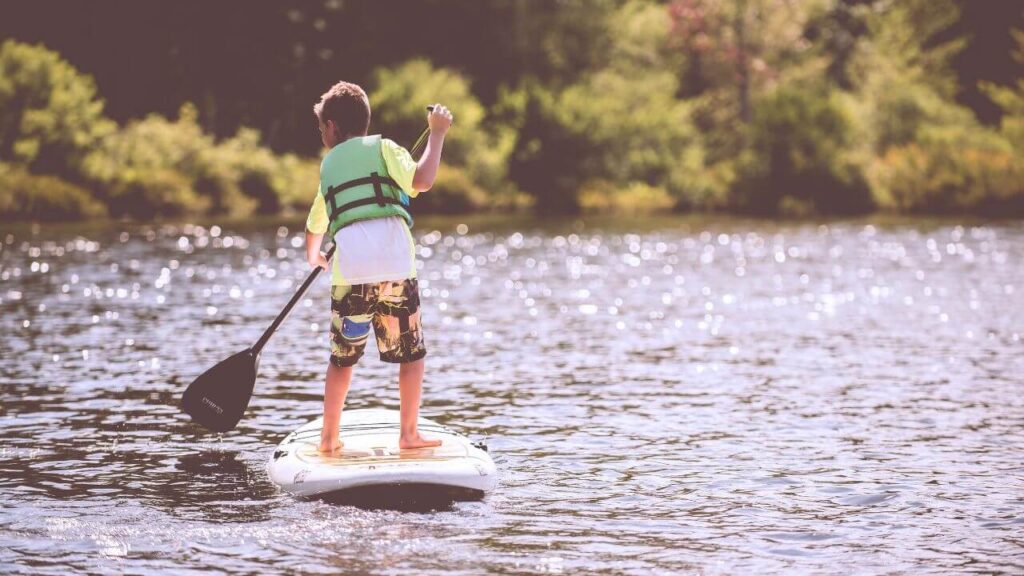
Best Time for Stand-Up Paddleboarding
The best time to engage in SUP in Boracay is during the dry season, which runs from November to April. During this period, the sea is calm, and the skies are clear, providing ideal conditions for paddleboarding. The wet season, from May to October, can bring stronger winds and occasional rains, which might make paddleboarding more challenging, especially for beginners.
Suitability for Kids and Families
SUP is a highly family-friendly activity, suitable for kids and adults alike. Children as young as 8 or 9 can learn to paddleboard, especially in the calm waters of Boracay’s beaches. It’s an excellent activity for families looking to enjoy the water together, offering a fun, low-impact way to explore the island’s coastlines.
For families with very young children, the child can sit on the board while an adult paddles, turning it into a relaxing and enjoyable excursion for the whole family. Additionally, SUP can be a delightful way for seniors to enjoy the water, as it doesn’t require rigorous physical exertion and can be done at a leisurely pace.
Canyoning in Dalat (Vietnam)
Canyoning in Dalat, Vietnam, is an adventurous and thrilling way to explore the region’s unique terrain. Dalat, known for its lush landscapes and diverse natural features, including waterfalls, rivers, and canyons, is a prime destination for canyoning enthusiasts. This activity combines hiking, climbing, swimming, and abseiling (rappelling) through the rugged and beautiful canyons of Dalat, offering an adrenaline-filled experience for adventure seekers.
Navigating Dalat’s Waterfalls and Canyons
Canyoning in Dalat involves navigating a series of obstacles in a canyon, typically rappelling down waterfalls, sliding down natural water slides, and jumping into pools of water. It’s a physically demanding activity that lets participants experience the area’s natural beauty in a unique and exhilarating way. The waterfalls and rivers in Dalat provide natural courses for canyoning, with varying levels of difficulty and challenge.
Canyoning Tours and Skill Requirements
Canyoning Tours: Several tour operators in Dalat offer guided canyoning experiences. These tours are designed to cater to different skill levels, from beginners to experienced canyoners.
Skill Requirements: Basic physical fitness is necessary for canyoning. While previous experience in rock climbing or rappelling is beneficial, it’s not required for beginner courses. Tour operators provide necessary training before the actual canyoning begins.
Safety Gear and Instructions: All necessary safety gear, including helmets, harnesses, and ropes, is provided by the tour operators. Professional guides ensure that participants receive comprehensive safety instructions and are always available to assist.
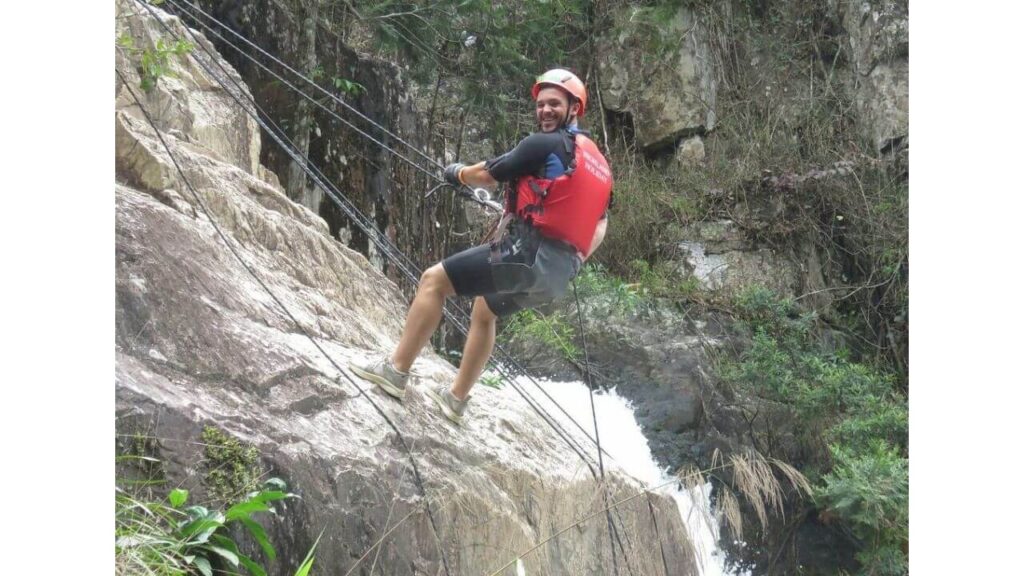
Photo Source: Tripadvisor.com
Best Time for Canyoning
The best time to go canyoning in Dalat is during the dry season, from November to April. During these months, the weather is more stable, and the water levels are moderate, making navigating the canyons safer and more enjoyable. The rainy season, from May to October, can make canyoning more challenging and risky due to higher water levels and stronger currents.
Suitability
Canyoning in Dalat is most suitable for adventure seekers, including solo travelers, groups of friends, and families with older children (usually teenagers). It requires a good level of physical fitness and a sense of adventure.
For Kids and Families: Canyoning can be suitable for families with older children who are physically active and comfortable with water and heights. However, it might not be suitable for very young children.
For Seniors: While canyoning is generally a high-energy activity, seniors who are in good physical condition and have an adventurous spirit might enjoy it. However, assessing individual capabilities and choosing a tour that matches one’s fitness level is important.
Snorkeling in the Similan Islands (Thailand)
Snorkeling in the Similan Islands, a group of islands in the Andaman Sea off the coast of Thailand, is an unforgettable experience for marine life enthusiasts and nature lovers. The Similan Islands are renowned for their crystal-clear waters, vibrant coral reefs, and diverse marine life, making them one of the top snorkeling destinations in the world.
Exploring the Similan Islands
The underwater world of the Similan Islands is a mesmerizing spectacle of colors and activities. The clear waters provide excellent visibility, allowing snorkelers to witness a stunning array of marine life, including a variety of fish species, sea turtles, and colorful corals. The islands’ unique underwater topography, which includes huge boulders, coral gardens, and underwater caves, adds to the excitement and allure of snorkeling in this region.
Best Time to go
The ideal time to visit the Similan Islands for snorkeling is between November and April. During these months, the sea is calm, and the weather conditions are most favorable, ensuring the best underwater visibility and overall snorkeling experience. The islands are closed to tourists from mid-May to mid-October during the monsoon season to help preserve the marine environment.

Guidelines for Environmentally Responsible Snorkeling
Do Not Touch or Step on the Corals: Corals are delicate and can be easily damaged. Snorkelers are advised to maintain a safe distance to protect the underwater ecosystem.
Avoid Feeding Fish: Feeding fish can disrupt their natural behavior and diet.
Dispose of Waste Properly: Ensure all trash is taken back to the mainland and disposed of responsibly.
Use Eco-Friendly Sunscreen: Chemicals in some sunscreens can harm marine life. Using reef-safe sunscreen helps protect the ecosystem.
Suitability for Children and Families
Snorkeling in the Similan Islands is a family-friendly activity suitable for children and adults. The calm and shallow waters near some of the beaches provide a safe environment for children and beginner snorkelers. It is a wonderful way for families to bond and learn about marine conservation.
For Kids: Many tour operators provide child-sized snorkeling gear, which can be a fun and educational experience for children. However, it is important for parents to always supervise their children in the water.
Sea Kayaking in El Nido (Philippines)
Sea kayaking in El Nido, located in the Palawan province of the Philippines, is an enchanting experience showcasing some of Southeast Asia’s most breathtaking scenery. Known for its crystal-clear waters, stunning limestone cliffs, and hidden lagoons, El Nido offers a unique kayaking adventure that is both serene and exhilarating.
Paddling Through El Nido’s Natural Wonders
Kayaking in El Nido allows you to navigate through its magnificent lagoons and around its dramatic limestone formations at your own pace. This activity offers an intimate way to explore hidden areas that larger boats can’t access, such as secret beaches and secluded coves. The tranquility of gliding over the water and the awe-inspiring landscapes make sea kayaking in El Nido a truly memorable experience.
Guided Tours and Tips for Kayakers
Guided Tours: For those new to kayaking or unfamiliar with the area, guided tours are available and provide an informative and secure way to explore. Guides can take you to the best spots and share local ecology and geography insights.
Independent Kayaking: More experienced kayakers may rent kayaks and explore independently. This offers more freedom to discover the area at your own pace.
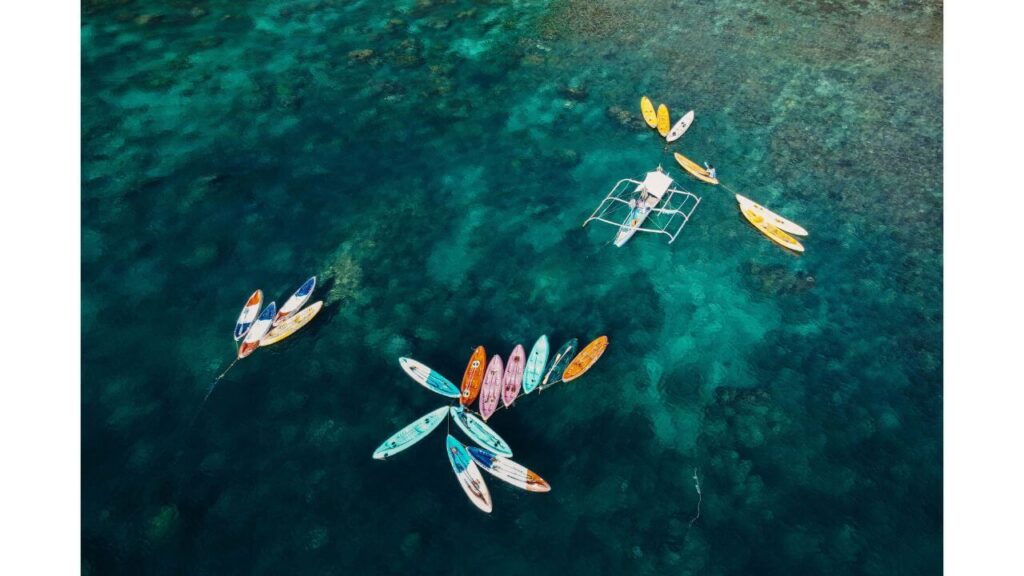
Tips for All Skill Levels
- Always wear a life jacket for safety.
- Be mindful of weather conditions and water currents.
- Stay hydrated and protect yourself from the sun.
- Respect the local wildlife and natural surroundings.
Best Time for Sea Kayaking
The best time to go sea kayaking in El Nido is during the dry season, from November to May. During these months, the sea is typically calmer, and the weather is more suitable for kayaking. From June to October, the rainy season can bring rougher sea conditions and reduced visibility, making kayaking more challenging.
Suitability for Families and Children
Sea kayaking in El Nido is a family-friendly activity that can be enjoyed by children and adults alike. It is an excellent way for families to spend time together, enjoying the natural beauty of El Nido.
For Kids: Children can join their parents in a kayak, usually sitting in the front while an adult paddles from the back. It’s a fun and safe way for them to enjoy the water and the scenery.
For Families: Many kayak rental places offer double kayaks, which are more stable and suitable for families with children. Always ensure that children wear life jackets and are under constant adult supervision.
Kitesurfing in Sri Lanka, One of the Best Thrilling Water Adventures
Kitesurfing in Sri Lanka is becoming increasingly popular, attracting enthusiasts worldwide to its beautiful beaches and favorable wind conditions. Sri Lanka’s diverse coastline offers various spots ideal for kitesurfing, ranging from calm lagoons for beginners to challenging waves for more experienced riders. The combination of consistent winds, warm waters, and scenic landscapes makes Sri Lanka a top destination for kitesurfing.
The Thrill of Kitesurfing in Diverse Wind Conditions
Kitesurfing in Sri Lanka offers a unique experience due to the island’s varied wind conditions. The country’s two monsoon seasons result in different wind patterns, which cater to kitesurfers of all skill levels. Beginners can enjoy steady and moderate winds, while advanced kitesurfers can challenge themselves with stronger gusts and bigger waves. The exhilarating feeling of gliding over the water with the kite powering your movement provides an unmatched sense of freedom and adventure.
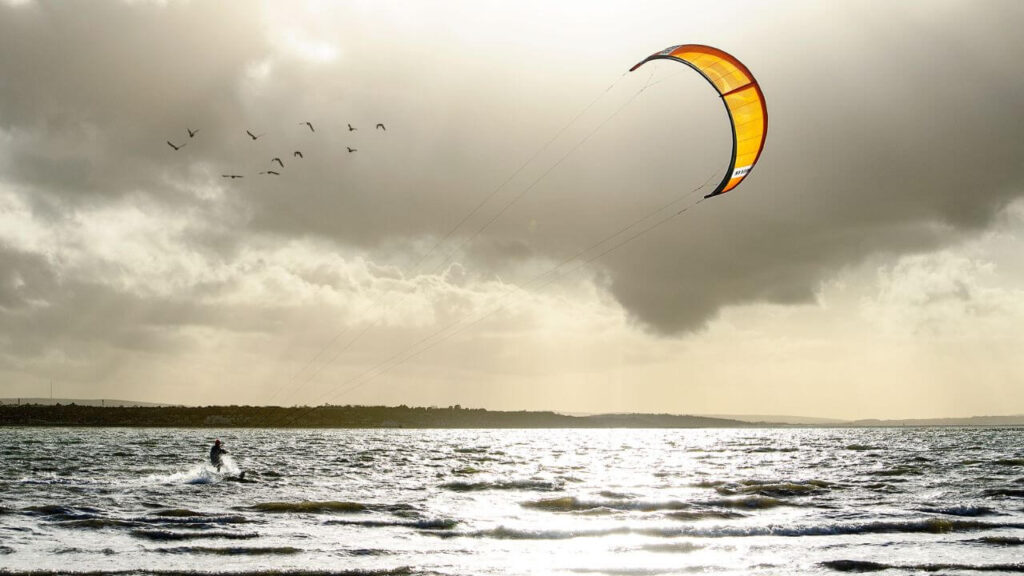
Best Spots for Kitesurfing
Kalpitiya: Located on the northwest coast, Kalpitiya is the most popular kitesurfing destination in Sri Lanka. It offers a large lagoon with flat water, perfect for beginners and freestyle kitesurfers.
Arugam Bay: Known for its surfing, Arugam Bay on the east coast also offers excellent conditions for kitesurfing, particularly for those who enjoy wave riding.
Mannar: The Mannar region, with its consistent winds and uncrowded beaches, is a hidden gem for kitesurfers. The area offers both flat water and wave spots.
Best Seasons for Kitesurfing
Kitesurfing in Sri Lanka is best during the two main wind seasons:
- May to October: The southwest monsoon brings strong and consistent winds to the northwest coast, making Kalpitiya ideal during this period.
- December to March: During the northeast monsoon, the wind conditions are excellent on the east coast, particularly around Arugam Bay.

Asia’s top 10 thrilling water adventures present a diverse and exhilarating range of experiences, catering to all levels of thrill-seekers. From the serene beauty of kayaking in Vietnam’s Ha Long Bay to the adrenaline-fueled excitement of kitesurfing in Sri Lanka, each activity offers a unique way to connect with nature and experience the joy of water sports. Whether exploring the underwater wonders while scuba diving in the Coral Triangle or feeling the rush of white water rafting on the Ganges, these adventures provide unforgettable experiences highlighting Asia’s natural beauty and cultural richness. Suitable for families, solo travelers, and adventurers of all ages, these water activities promise excitement and fun and foster a deeper appreciation for our planet’s aquatic environments. We hope you find your best adventure in these thrilling Asian water adventures. Also, you can read here about The Best Family Adventure Activities in Asia.

